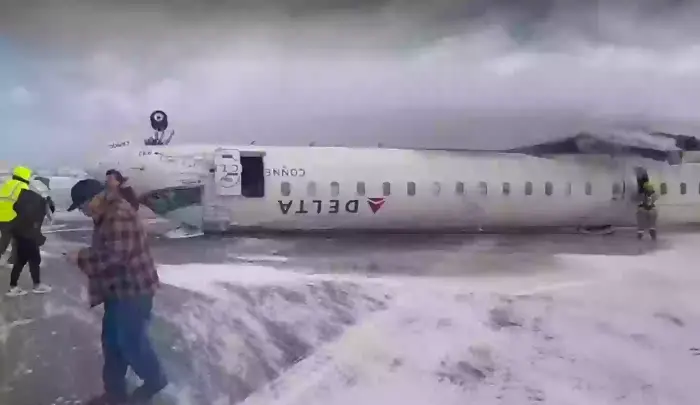On February 17, 2025, a Delta Air Lines aircraft operating as Flight 4819 experienced a dramatic incident upon landing at Toronto Pearson International Airport. The incident, which was captured on newly released video footage, has attracted significant attention from aviation experts and the media alike.
Incident Overview
According to multiple eyewitness accounts and initial reports, Flight 4819 made a forceful landing on the airport’s snowy runway. Shortly after touchdown, the aircraft appeared to lose balance and flipped over before erupting into a large fireball. Despite the dramatic visuals, preliminary information indicates that all 80 individuals aboard—comprising 76 passengers and four crew members—survived the incident. However, at least 18 people sustained injuries, three of whom required transport via air ambulance to nearby hospitals.
The footage, which was shared widely on social media, shows the aircraft making a sudden, uncontrolled descent onto the runway. Flames were visible shortly after the plane appeared to flip, capturing a moment that both shocked onlookers and raised questions about the contributing factors to the mishap.
Eyewitness Accounts and Passenger Experiences
One of the passengers, Peter Carlson, provided a firsthand account of the event. Recounting the chaos, Carlson explained, “All of a sudden everything just kind of went sideways, and then next thing I know, it’s kind of a blink and I’m upside down still strapped in.” His statement reflects the unexpected and jarring nature of the event, as passengers experienced an abrupt transition from a routine landing to a situation that seemed to defy normal expectations.
Survivors have also uploaded footage from within the cabin, offering a rare glimpse into the immediate aftermath of the crash landing. The internal recordings capture the initial impact, the disorientation felt by those on board, and the rapid deployment of emergency protocols by the flight crew. Despite the unsettling nature of the incident, the successful evacuation and absence of fatalities highlight the robust safety measures in place for commercial air travel.
Expert Analysis on Contributing Factors
Aviation experts have largely attributed the incident to severe weather conditions prevailing at the time of the landing. CNN aviation analyst Peter Goelz noted that a strong gust of wind, potentially compounded by the snowy conditions on the runway, might have played a critical role in the aircraft’s loss of control. According to Goelz, “The combination of high winds and winter weather conditions likely disrupted the expected aerodynamic performance of the aircraft during its final approach.”
Similarly, aviation expert Scott Hamilton, speaking to Newsweek, suggested that the environmental conditions at Toronto Pearson—including gusty winds and the presence of snow—were significant contributors to the plane’s destabilization upon touchdown. Hamilton emphasized that while modern aircraft are engineered to withstand challenging weather conditions, extreme scenarios can sometimes test the limits of both the aircraft and the pilots’ ability to respond.
John Cox, a seasoned aviation safety expert, remarked on the rarity of such occurrences. “We’ve seen a couple of cases of take-offs where airplanes have ended up inverted, but it’s pretty rare,” Cox stated. He further explained that while the aircraft are designed and certified to handle adverse weather, there are instances where sudden and unexpected wind patterns can exceed the operational thresholds, resulting in accidents that, while survivable, still pose significant risks to those on board.
The Role of Weather and Pilot Response
Toronto Pearson International Airport is known for its challenging winter conditions. On the day of the incident, weather reports confirmed winds out of the west at speeds ranging between 27 and 35 knots (approximately 38 miles per hour or 61 kilometers per hour). Such wind speeds, particularly in a winter storm scenario with accumulating snow, can dramatically affect runway traction and aircraft handling during critical phases of flight such as landing.
The pilots, who are highly trained to manage these variables, executed their emergency protocols in response to the unexpected turbulence and impact forces. Despite the severity of the incident, the effective management of the situation by the flight crew, combined with the resilient design of the aircraft, ensured that there were no fatalities. The incident underscores the importance of rigorous training and robust safety systems in mitigating the effects of adverse weather during flight operations.
Ongoing Investigation and Future Implications
Authorities have promptly initiated a comprehensive investigation to determine the full sequence of events leading to the crash landing. Investigators are currently working to recover the aircraft’s flight recorder and cockpit audio recorder, devices that are critical in reconstructing the flight’s final moments. These black boxes will provide invaluable data, including cockpit communications and technical flight parameters, to help determine whether the weather, pilot input, or potential mechanical issues were primary factors in the accident.
The investigation will also look into the runway conditions at Toronto Pearson during the incident. Understanding how snow accumulation, ice formation, and wind patterns may have contributed to the loss of control is essential in developing improved safety protocols and mitigating similar risks in the future.
Implications for Aviation Safety
While the incident remains under investigation, it serves as a potent reminder of the challenges that weather can pose to aviation safety. The fact that all occupants survived the crash landing is a testament to the advancements in aircraft design and pilot training. However, aviation safety experts caution that even with these safeguards, extreme weather conditions can still produce unforeseen hazards.
The industry continues to evolve, with ongoing efforts to enhance predictive weather modeling, improve runway safety, and refine pilot training programs to better prepare for such rare but impactful events. As aviation authorities analyze the data from Flight 4819, there is potential for implementing additional measures that could further reduce the likelihood of similar incidents in the future.
🔴 A newly released video shows the exact moment of the impact of Delta Connection flight 4819 at YYZ
by airmainengineer#deltaairlines #avgeek #accident pic.twitter.com/2BqnqPyxVn
— Airways Magazine (@airwaysmagazine) February 18, 2025
